McDonald’s is the largest fast-food chain in the world, serving $70 million of the 70 million customers who enter its golden arches every day. But McDonald’s is not just about burgers; they are also one of the largest real estate owners in the world, with $42 billion in properties, making it one of the most interesting cases on the Stock Exchange.
In this article, I’ll show you how a hot dog stand became an empire, present in over 100 countries and with a yearly profit of $8.5 billion. Stick around till the end to learn how you too can invest in McDonald’s and get a slice of that apple pie.
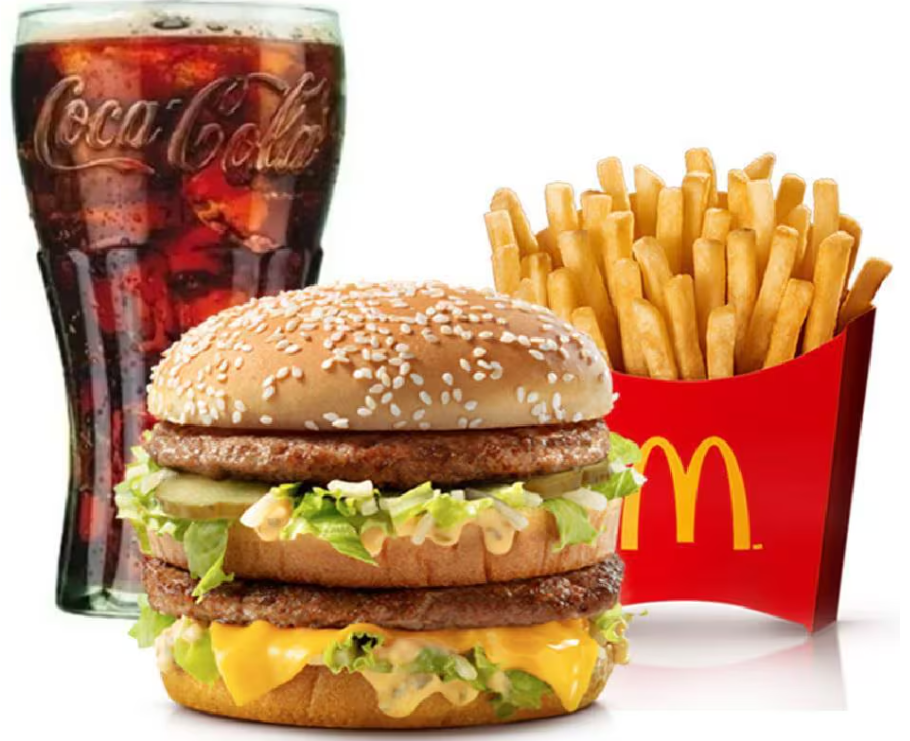
The concept of fast-food emerges
It all began when brothers Richard and Maurice McDonald, Dick and Mac, were struggling with a failing movie theater in Hollywood. They noticed that the hot dog stand across the street always had more customers.
They decided to open their own fast-food business in San Bernardino, California, in 1940, and eight years later, they introduced the “Speedee” system of quick and self-service preparation for hamburgers, fries, and milkshakes. This model had been created by another cultural icon that still exists today, White Castle, but nowadays fast-food is almost synonymous with McDonald’s.
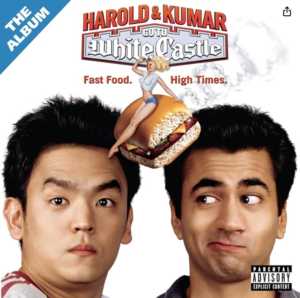
In ’54, a fifty-year-old milkshake machine salesman named Ray Kroc visited the diner that had ordered 8 of his machines and was impressed by the efficiency of Dick and Mac’s business model. He then bought the franchise rights and in ’55 founded McDonald’s Inc., the corporation we know today.
Due to disagreements with the McDonald brothers about the company’s expansion model, in 1961 Kroc bought out the last of the brothers’ shares for $2.7 million, which today would be equivalent to $27 million. It was one million for each brother, plus $700 for income tax.
This story was portrayed in the movie “The Founder,” which also features Harry Sonneborn. In his words:
“We are not technically in the food business. We are in the real estate business. The only reason we sell hamburgers for 15 cents is because they are the greatest producers of revenue from which our tenants can pay us rent.”
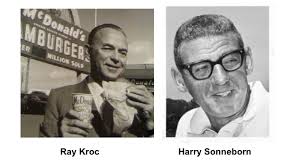
Sonneborn was the first president of the company, serving from 1959 until his resignation in 1967 when he fell out with Kroc and sold all his shares for $3 million, never setting foot in a McDonald’s again.
Had he waited to sell, he would have made over $100 million by 1977, and at the time of his death in 1993, he would have been a billionaire. Ray Kroc himself died in 1984 with the equivalent of billions of dollars today.
Going public with 700 stores
In April 1965, with 700 stores, McDonald’s went public (ticker MCD) at $22.50 per share, and the next day it was already at $30. If you had bought 100 shares at the IPO, you would have spent $2,250 and today would have 74,000 shares, considering the 9 stock splits since the IPO, the last one in ’99.
So those $2,000 in shares would be worth $20 million today. But these numbers are just to show you the scale the company has reached. Of course, you don’t need to have entered the IPO of any company; you can profit from stocks at any point in a company’s cycle.
We’ll get to the chart soon so you can see how to do that in practice, but first let’s understand the business engineering that enables over 40,000 McDonald’s locations worldwide, with a new one opening every 5 hours in 2023.
Some milestones in the company’s history include the launch of the Big Mac and expansion overseas in 1967, the Drive-Thru in 1971, the Happy Meal in 1984, and today it is the largest distributor of toys in the world, the largest owner of playgrounds, and the largest purchaser of beef, potatoes, and apples in the United States.
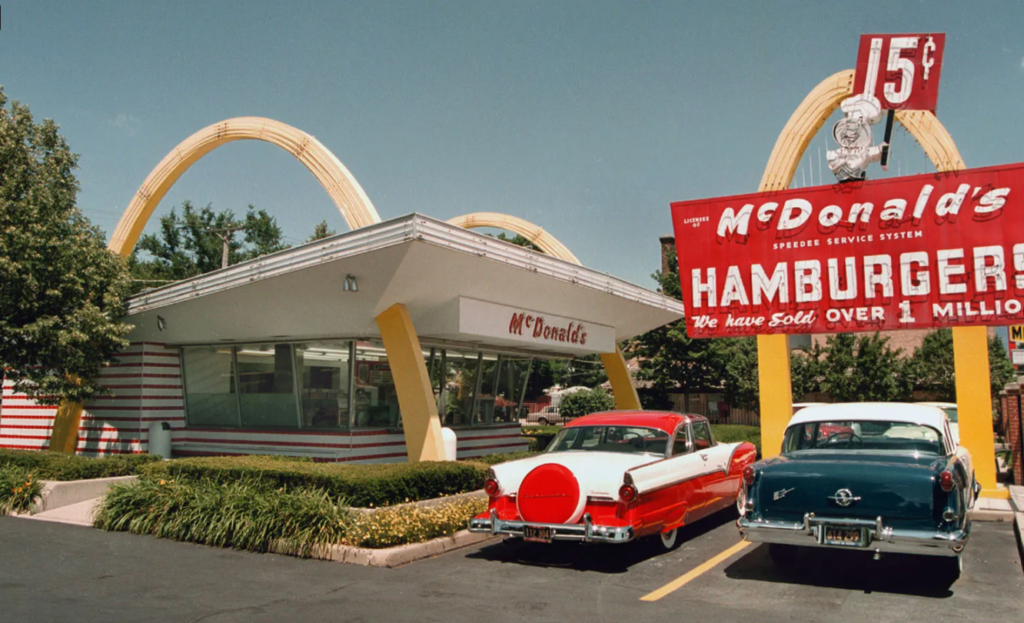
Today there are nearly 42,000 points of sale
In 2023, McDonald’s opened 1,900 new stores worldwide, totaling 41,800, with 21,000 being regular restaurants and the rest being McCafés and dessert kiosks. 95% of the total are franchises, with only 5% being company-operated, showing that the ‘Sonneborn model’ is doing well, thank you.
What sets this franchise model apart from competitors like Subway and Burger King is that most of the parent company’s revenue comes not from product sales but from rent, which represents two-thirds of what the company receives from franchisees. The other third comes from royalties for the use of the brand, and less than 1%, $150 million, comes from the initial franchise fee of $45,000.
When someone decides to open a McDonald’s store, they first apply to show that they have the means, with a minimum net worth of half a million dollars. If you are accepted, you are trained at Hamburger University, which has trained nearly 300,000 people since ’61, with headquarters in Chicago and a branch in São Paulo.
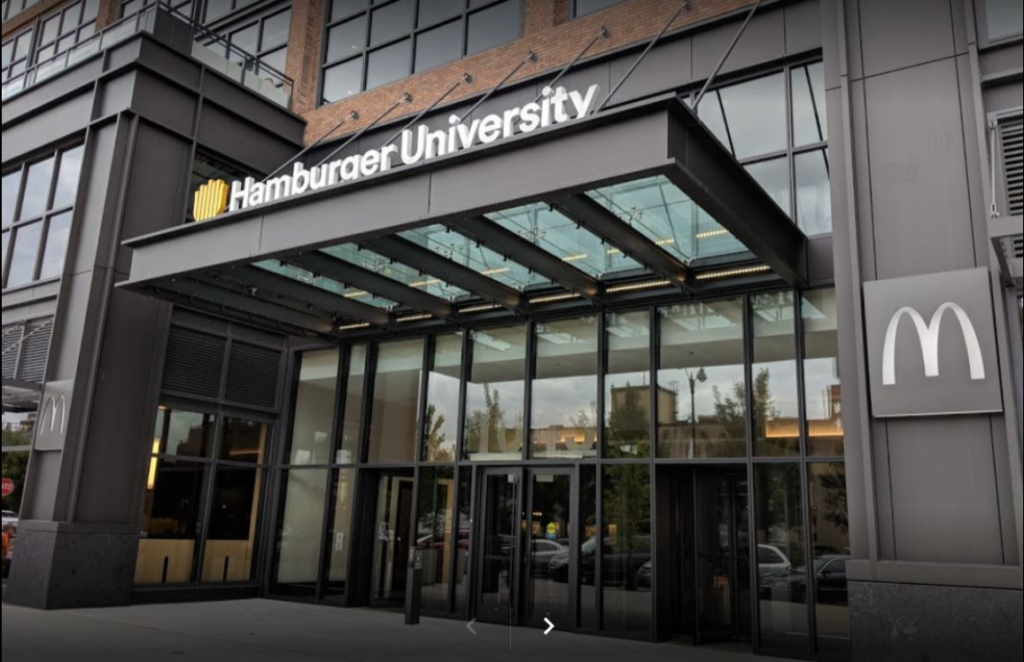
You need 1 to 2 million bucks to open a Mac
The total cost to open a McDonald’s franchise ranges between $1 and $2 million, with a strict contract stipulating all the details of the business, from how to make the hamburgers to operating hours and who the suppliers will be. These contracts are usually for 20 years, with a clause defining McDonald’s business model:
The store can only operate at that address, owned by the company. In other words, they ensure they always have a tenant, and that tenant will have money to pay the rent by selling burgers. Besides guaranteeing rental income, this diversifies the company’s risk and has tax benefits. Even if a store fails, they can find another owner or sell the property.
In other franchise networks, store owners spend 6 to 10% of their revenue on rent, while McDonald’s franchisees spend 8 to 15%. From the franchisee’s point of view, who paid over $1 million for the right to manage a McDonald’s for 20 years, this makes sense because despite the high initial investment, it offers a low-risk return.
Those who open a store make a profit of $60,000/month
The average revenue of a McDonald’s store is $2.7 million per year, with a profit of $154,000, over $12,000 per month. So, if you invested $1.2 million to open a McDonald’s, you would have a 1% return per month. You will work hard, but you will have a salary of $60,000. This is because anyone passing by your store already knows the brand, in addition to having the headquarters always investing in marketing and new products.
The largest franchisee is Arcos Dorados, which owns more than 2,000 stores in Latin America and the Caribbean, of which 1/3 are sub-franchised. More than $100 million of McDonald’s revenue comes from this franchise, which went public in 2011. Almost half of this revenue comes from Brazil, which has over a thousand stores and 2,000 McDonald’s kiosks.
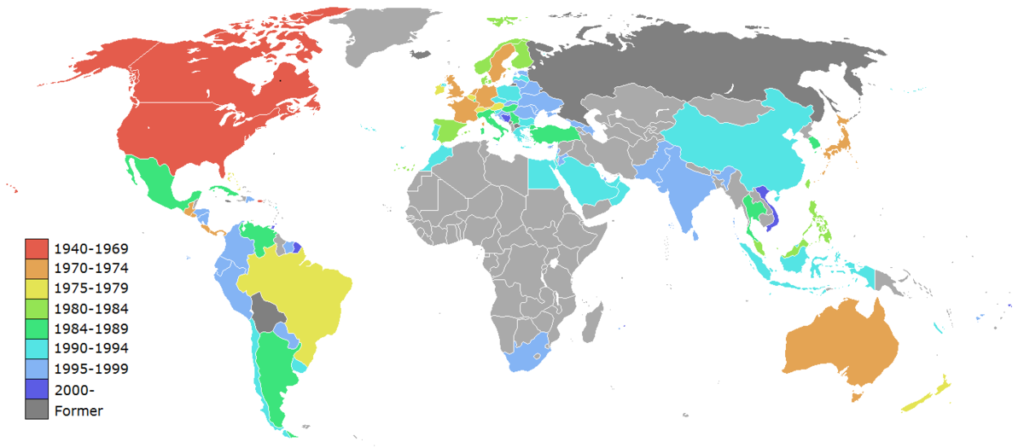
A brand symbol of globalization
McDonald’s is a brand that has become a symbol of modern and globalized lifestyle. It has even been said, by Thomas Friedman, that two countries with McDonald’s do not go to war, but that’s probably an exaggeration. Its 41,800 stores are spread across more than 110 countries, and in all of them, the fries will taste the same, and the milkshake machine will be broken.
The omnipresence is such that, in 1986, The Economist developed the Big Mac Index, a way to determine if a country’s currency is inflated. Since the Big Mac is a globally available product, according to the theory of purchasing power parity (PPP), exchange rates move in a direction that equalizes the prices of an identical basket of goods and services, in this case, the Big Mac.
In today’s “Burgernomics,” for example, a Big Mac costs $24 in Brazil and $5.70 in the United States. The implied exchange rate is 4.20. Since the real exchange rate today is at $5 per dollar, the Brazilian real tends to appreciate by 16%.
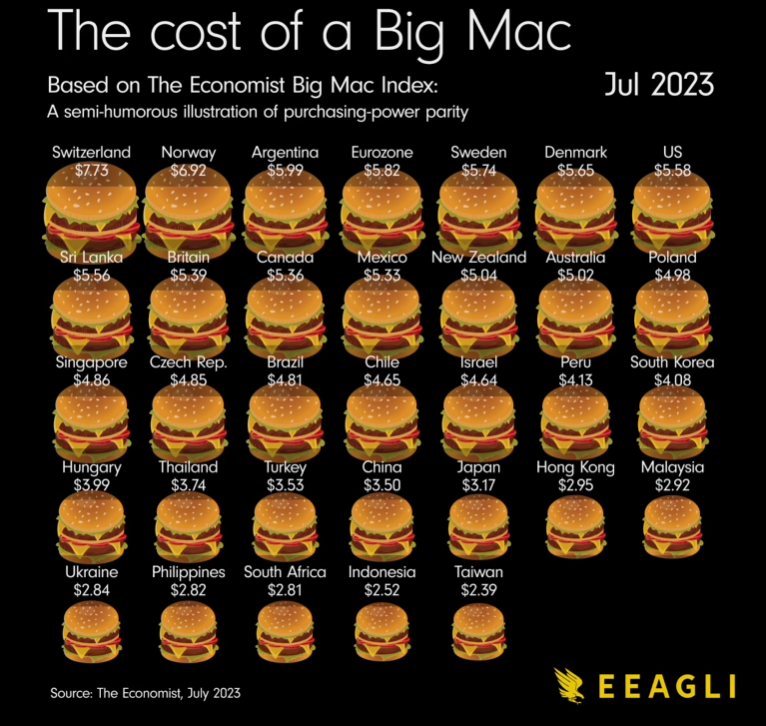
The headquarters make 4 times more profit in a franchised store
McDonald’s is the world’s largest food retailer, with a revenue of $25 billion in 2023, 10% more than the previous year, and it is a ‘dividend aristocrat’, paying increasing dividends since ’76, almost 50 years.
$10 billion of the revenue comes from sales in company-owned stores, and $15 billion from franchised ones. These are much more profitable, providing an 80% operating margin, as in company-owned stores McDonald’s has to bear all the costs, ending up with only about 20% profit, while in the others it’s just about collecting the franchise fee and rent.
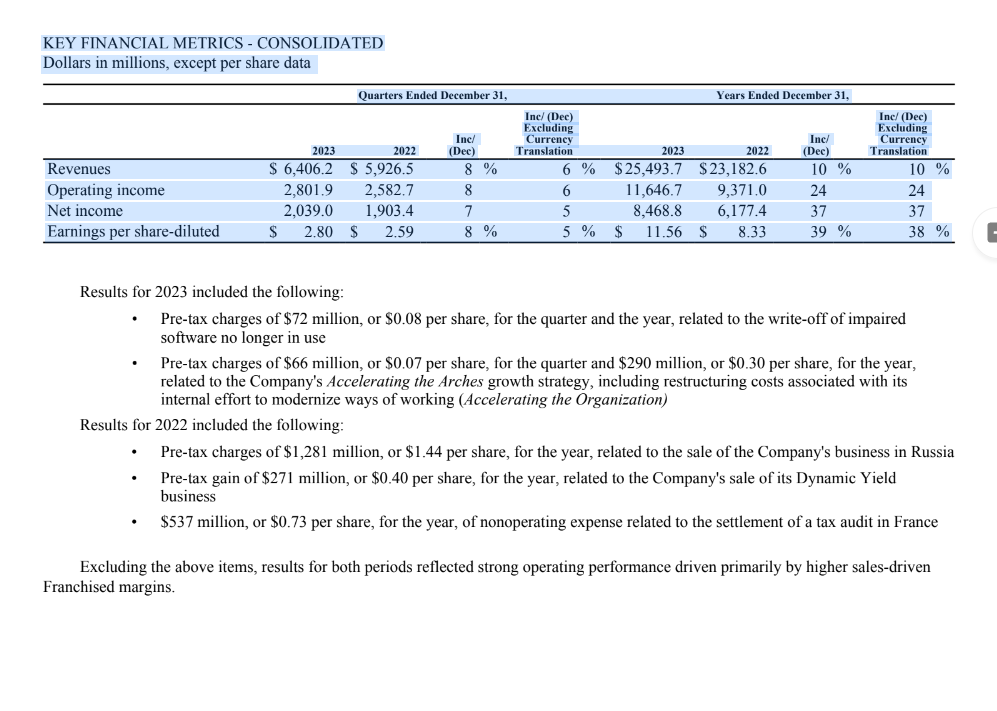
Achieving a 33% profit margin with restaurants is indeed impressive.
However, this is what the headquarters, McDonald’s Inc., generates, while total sales at the stores amount to $125 billion per year, representing a 5% market share in the global restaurant industry, estimated at $2.5 trillion.
Of the $25 billion that the headquarters generates, $8.5 billion is profit, resulting in a net margin of 33%. The company’s net worth in 2023 was $56 billion, of which $42 billion, or three-quarters of it, are real estate assets, as 80% of the stores are owned by the company. With each store averaging 5,000 square meters, McDonald’s owns a total of 190 square kilometers of land, equivalent to the size of a small country.
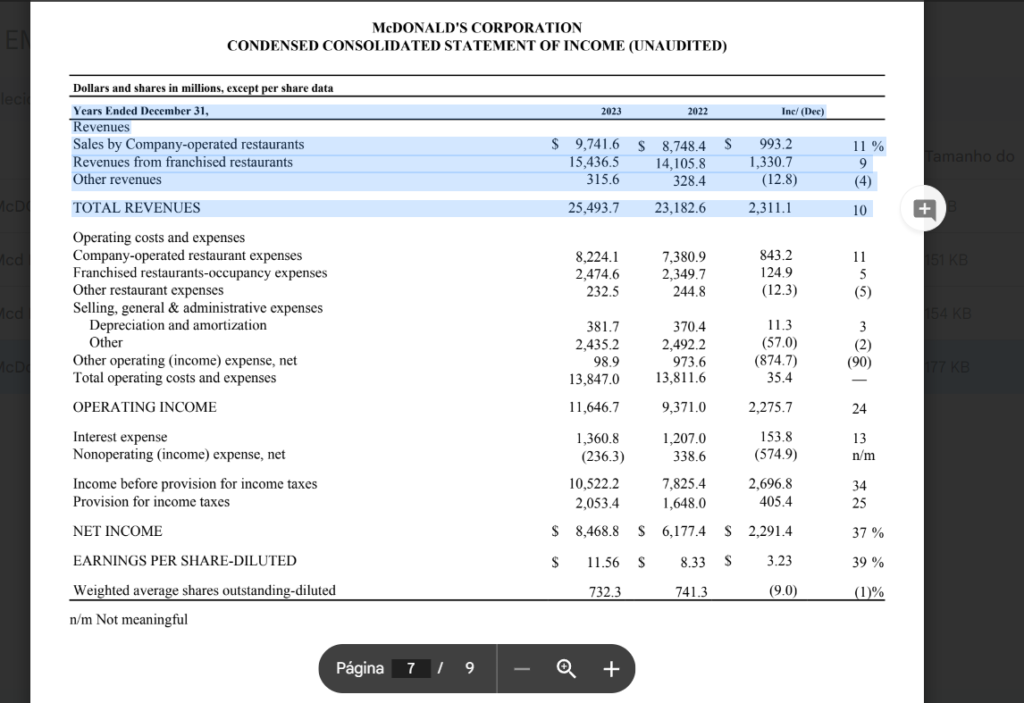
1 in 8 Americans has worked at McDonald’s
McDonald’s is the second-largest private employer in the world, with 150,000 employees in its own operations and 2 million in its franchises, trailing only Walmart, which has 2.3 million employees.
From Pharrell Williams to Jeff Bezos, one out of every 8 Americans has worked at McDonald’s. There’s even the term “McJob,” referring to a low-wage job with few prospects. But if you go on to open an Amazon later, you’re forgiven.
If you add up all 720 million shares at today’s stock price of $270 per share, McDonald’s market value in April 2024 is nearly $200 billion. This places it among the top 60 largest companies in the world, more than double the second-place player in the field, Chipotle, valued at $80 billion, which incidentally used to be owned by McDonald’s until it went public in 2006.
Any restaurant or food stand is a competitor of McDonald’s, but the biggest ones include Burger King, with annual revenues of $20 billion, and Subway, which at one point had 10% more stores. These two have privately held stock. Among those you can trade on the stock market are Starbucks, which has at times outpaced McDonald’s in revenue, Wendy’s, and Yum Brands, the owner of KFC, Taco Bell, and Pizza Hut.
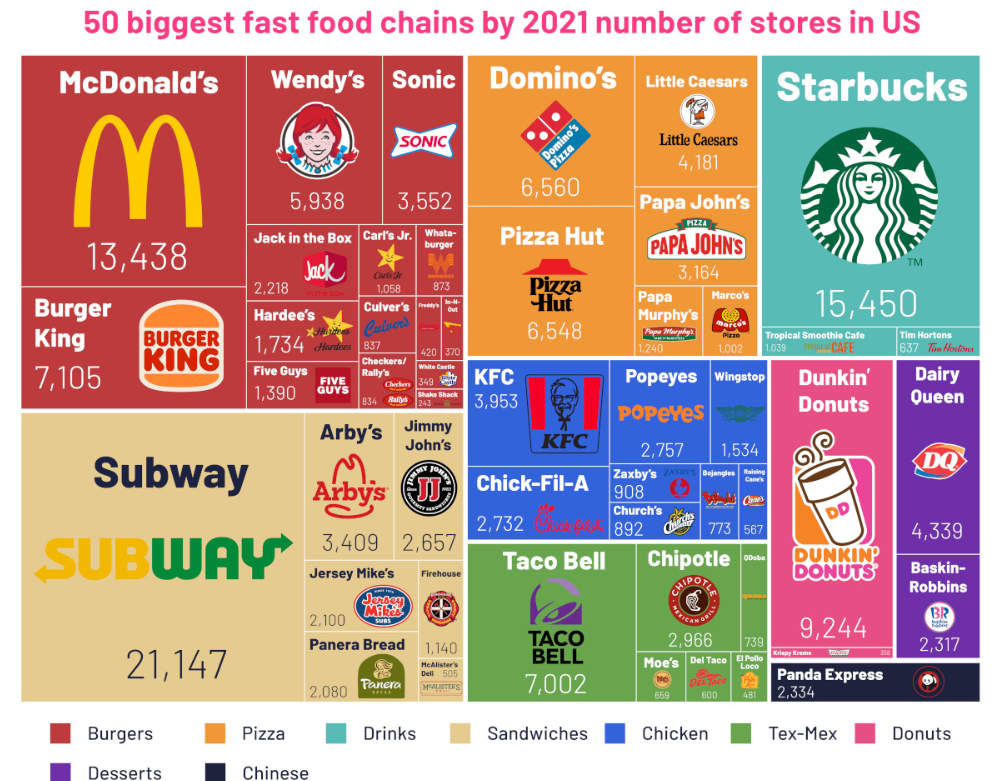
A brand that’s always reinventing itself
McDonald’s is one of the most iconic companies in the world, with branding and marketing that have made the golden arches the second most recognized symbol in the world after the Christian cross. Imagine how many burger joints there are in your city and how many of them have opened 40,000 branches in 110 countries and are pulling in $25 billion after 60 years, and you’ll understand what McDonald’s is all about.
Fifteen years ago, you’d go through the drive-thru and always find something missing from your order, but today you walk into a store and there’s self-service, clean restrooms, and the “Forever Young” lounge, showing that not even “Super Size Me” can defeat this company.
In the words of Ray Kroc:
“If you believe, and you believe very strongly, anything is possible.”
Watch the video for more on McDonald’s Corporation:
>> See also:
